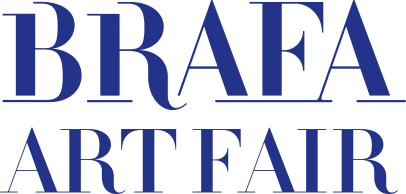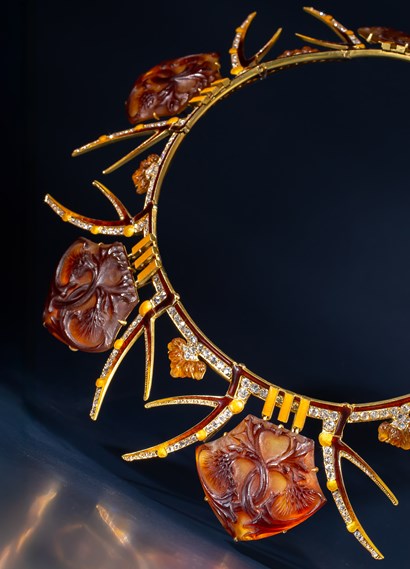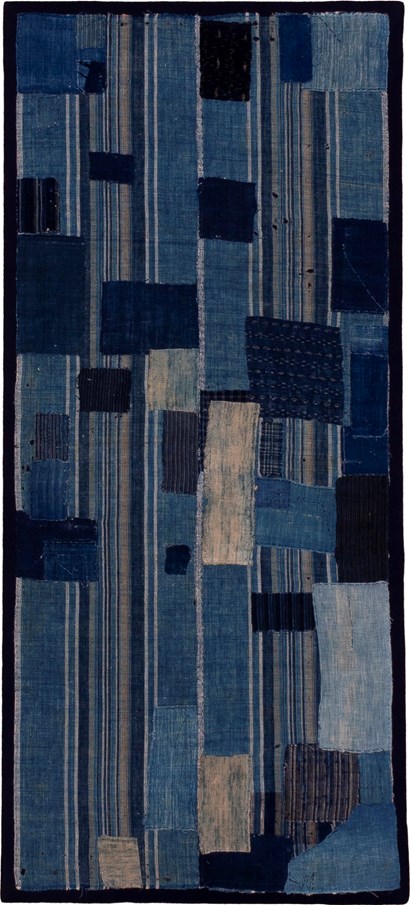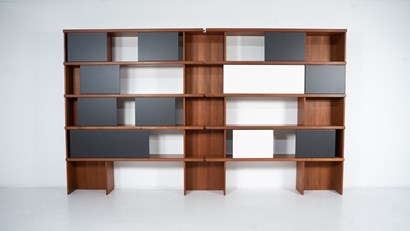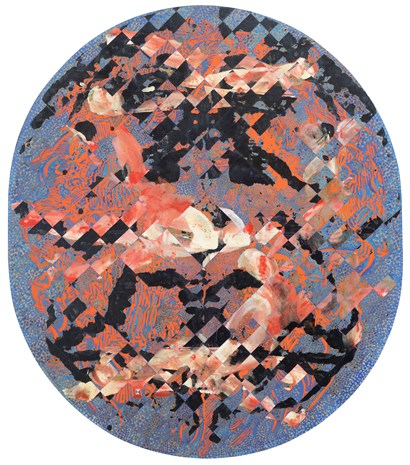This section will be available this Autumn.
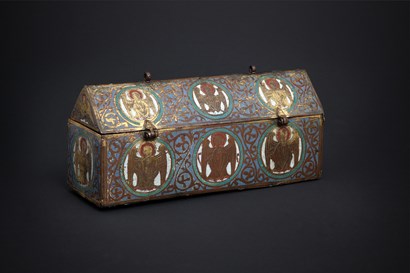
Art et Patrimoine - Laurence Lenne
Reliquary 'in the form of a sarcophagus with a hinged roof' Limoges, mid-13th century Gilt copper plates, champlevé enamels H 11.8 x W 27.5 x D 9.5 cm Literature: Inventaire général des monuments et des richesses artistiques de la France. Emaux limousins du Moyen Age. Correze/Creuse/Haute-Vienne, under the direction of Paul-Édouard Robinne, Éditions de l’Inventaire, Images du Patrimoine, 1995; Emaux de Limoges XIIè-XIXè siècle, under the direction of Jacques Toussaint, Museum of Ancient Arts of Namur, 1996; Valérie & Thomas Becket, De l'influence des princes Plantagenêt dans l'Oeuvre de Limoges, Municipal Museum of the Bishop’s Palace-Museum of Enamel, Limoges, 1999 A reliquary, without a wooden core, taking the shape of a sarcophagus with a hinged roof. It is made of gilt copper plates and decorated with champlevé enamels depicting sixteen half-length angels emerging from clouds against a white enamel background. The decoration consists of two superimposed registers of three engraved gilt angels set within round medallions. The medallions stand out against a blue enamel ground adorned with gilded Gothic foliage and interlace patterns. This reliquary belongs to a series of standardised reliquaries known from the Limousin region, all dating from the 13th century. Its dimensions make it one of the largest examples of this 'sarcophagus with movable roof' type. It is closely related to the exceptional large reliquary of Saint-Yrieix-la-Perche, classified as part of the Treasure of the French Historic Monuments.

Galerie BA - Berthet Aittouarès
henri michaux
Henri Michaux (Namur 1899-1984 Paris) Untitled, 1964 Ink on paper 75 x 105 cm Monogrammed on the lower right This work is registered in the Henri Michaux archives under the number HM5891 Provenance: Galerie Daniel Cordier, Paris; private collection, France Exhibition: Henri Michaux, Musée national d'Art Moderne, Paris, 1965

Galerie Cento Anni
philippe wolfers
Philippe Wolfers (Brussels, 1858-1929) Fiançailles (Engagement), circa 1911 Bronze with brown patina and original marble base H 50.5 cm Signed Ph. Wolfers Lost-wax cast n° 1 Provenance: private collection, France Literature: La Dynastie Wolfers–de l’Art nouveau à l’Art déco, Werner Adriaenssens & Raf Steel, p. 396

Giammarco Cappuzzo Fine Art
Giovanni Giacomo Sementi (Bologna 1584-1636 Rome) The Triumph of David, circa 1630 Oil on canvas 137 x 159 cm Provenance: private collection, Italy Literature: M. Francucci, Giovanni Giacomo Sementi, Un dipinto di soggetto insolito, in Arte Cristiana, n° 869, 2012, pp. 143-148; M. Pulini, Rimini per Simone Cantarini, opere da raccolte private, Rimini 2012, pp. 20-21, fig. 20; A. Pellicciari, I'Eredita’ di Guido Reni, in la pittura in Emilia e in Romagna. The Seventeenth Century, edited by Andrea Emiliani, Milano, 1992; G. Puglia, Il Bastaro, fig. 36, pag. 79; M. Francucci, il naturalismo classicizzato nella Roma di Urbano VIII, LibroCo Italy, Florence, 2013; Ariccia, Gian Giacomo Sementi, Quaderni del Barocco, 2021, p. 8 fig. 14

Martos Gallery
keith haring
Keith Haring (USA, Pennsylvania 1958-1990 New York) Untitled, May 23, 1981 Marker on plastic 53.3 x 57.3 cm Provenance: Ellen Meyer collection, acquired directly from the artist; New York; Christie’s Auction, 1 May 1991, lot 313; private collection, Italy; Martos Gallery, New York Exhibition: Keith Haring: Surface to Air, Martos Gallery, New York, 6 May–25 July 2025

Claes Gallery
Reliquary Figure 'Mbulu-ngulu' Kota Kota-Obamba People Gabon, presumed late 19th-early 20th century Wood, copper and brass H 43 cm Provenance: private collection, Los Angeles, until 1979; private collection, Geneva Literature: L’Art Kota. Les figures de reliquaire, Chaffin, Meudon, 1979, pp. 234-235, fig. 133 (written height: 43.5 cm)

Harold t’Kint de Roodenbeke
Englebert Van Anderlecht (Brussels, 1918-1961) Rome 1, 1960 Oil on canvas 150 x 122 cm Signed, dated and titled on the reverse Inventory number 664 on the reverse Provenance: private collection, Brussels Literature: Serge Goyens de Heusch, Englebert Van Anderlecht, Mercator, 1998, ill. p. 207; Englebert Van Anderlecht, exhibition catalogue, MRBAB, Brussels, 1990, ill. n° 79 Exhibitions: Galerij M.A.S. Astene, march-april 1969; Museum van Deinze, Englebert Van Anderlecht, March-May 1990; MRBAB, Englebert Van Anderlecht, Brussels, 1990 In the shadow of war and its aftermath, Englebert Van Anderlecht began his career as an artist in the early 1940s, right in the midst of the global conflict. After this tragedy, the “young Belgian painting” movement brought together a group of artists in a state of euphoria. Their style was colorful and optimistic - a form of rebirth, a way to forget and move toward new horizons. By the late 1940s, there was a desire to recreate new rules - or rather, to affirm that there were no longer any rules. Creativity alone mattered and had to prevail over any form of academicism. Thus, Englebert Van Anderlecht turned toward abstraction at the end of the 1940s and definitively embraced it by the mid-1950s. His palette grew stronger, his tones deeper, and he adhered to a form of abstract expressionism. This style of painting reflected a worldwide desire for rupture and emancipation. In the United States, the tone was set by Jackson Pollock and Franz Kline, from gestural to abstract expressionism. In France, a new generation emerged with Nicolas de Staël, Pierre Soulages, Simon Hantaï, and Judith Reigl. Belgium was no exception, with Antoine Mortier and Englebert Van Anderlecht, the latter being the most committed to the path of free or abstract expressionism. “I believe it is essential that there be men who do not accept established rules, who do not believe that truth is forever what a few moral leaders have decided it to be, who see that life is not merely the sum of all discoveries made so far. In this, I see a promise of freedom. We believe that everything remains to be done, that our earth is young, that we are not old men sunk into routine, and that the marvelous still awaits us tomorrow.” - Text by Englebert Van Anderlecht, 1960 Within this context, the large and striking canvas, Rome I, belongs to the period of maturity and recognition of this artist, who died prematurely in 1961 at the age of 43. The brush or paintbrush seems to whirl across the canvas like a ballet. The tones are deep, intense, applied with palpable strength and energy, while the final result bursts forth across the space. The work then takes on its full dimension, filling the surface with unmatched power - one of the finest works by this essential figure of Belgian painting.
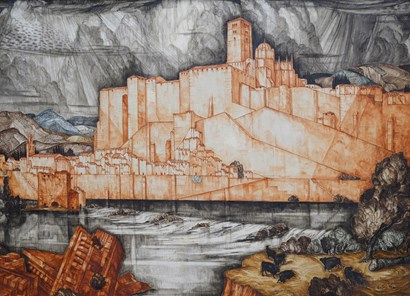
Philippe Heim
andré maire
André Maire (Paris, 1898-1984) Vue de Segovie, circa 1940 Oil on canvas 163 x 227 cm Signed lower right Certificate of authenticity issued by Philippe Heim Provenance: the artist's family Literature: André Maire (1898-1984), L'itinéraire décoratif d'un peintre voyageur, Éd. Gallimard, 16 October 2008, repr. p. 89 Exhibition: André Maire (1898-1984), L'itinéraire décoratif d'un peintre voyageur, Roubaix, La Piscine, 18 October 2008 to 1 February 2009

De Jonckheere
pieter brueghel the younger
Pieter Brueghel the Younger (Brussels 1564-1638 Antwerp) The Payment of the Tithe or the Village Lawyer, 1622 Oil on panel 78.9 x 123.2 cm Signed and dated: P. BREVGHEL, 1622 Provenance: private collection, Belgium; Galerie Legenhoek, Paris, 1991; private collection, France Literature: Ertz, Klaus, Pieter Brueghel der Jüngere: Die Gemälde mit kritischem Oeuvrekatalog, Lingen, Luca Verlag, Vol. I, 2000, p. 513, cat. E 507, repr.; Curie, Christina, Allart, Dominique, The Brue[H]el Phenomenon, Brussels, Royal Institute for Cultural Heritage, vol. III, p. 1030-1031 This Payment of the Tithe, or The Village Lawyer, is marked by Pieter Brueghel the Younger’s verve, meticulous execution, and vibrant colours. The satirical subject mocks the profession of the lawyer responsible for collecting the heavy tax that the poorest peasants struggled to pay. The grotesque faces of the petitioners, as well as the lawyer’s prognathous jaw - associating him with the Spanish authorities then in power - fascinate through their caricatural force. This original composition by Pieter Brueghel the Younger stimulated the market of the time, generating strong demand. The success of this still-relevant satire has endured to the present day.

Almine Rech
vivian springford
untitled
Vivian Springford (USA, Wisconsin 1913-2003 New York) Untitled, circa 1973 Acrylic on canvas 182.9 x 183.5 x 3.2 cm Provenance: estate of the artist Exhibition: Almine Rech, 'Gesture & Form: Women in Abstraction', May 3rd - June 15th, 2024, New York, Upper East Side Vivian Springford’s 'Untitled', circa 1973, encapsulates the American painter’s expressive, vibrant style. During the late 1960s, Springford had come into her own as an artist. She had developed a signature visual vocabulary and a technique of stain painting to go with it, working with thinned paint to create kaleidoscopic, gestural works.
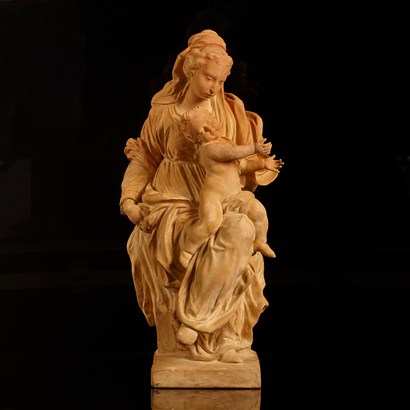
Floris van Wanroij Fine Art
rombout ‘pauli’ pauwels
Rombout ‘Pauli’ Pauwels (Mechelen circa 1625-1692 Ghent) The Virgin and Child Terracotta, sculpted on full round (contains restorations) H 52.5 x W 24 x D 23.5 cm Provenance: the Hulshoff Pol collection, Wassenaar, The Netherlands Literature: Neeffs, E. (1879), Histoire de la peinture et de la sculpture à Malines, Ghent, Vol. II, pp. 193-200; Nieuwdorp, H. (1977), De beeldhouwkunst in de eeuw van Rubens in de Zuidelijke Nederlanden en het prinsbisdom Luik, Brussels: KMKG, pp. 325-327 nrs. 294-298, p. 140, n° 103; Jacobs, A. & Vézilier, S. (2011), Fascination baroque: la sculpture baroque flamande dans les collections publiques françaises, Paris, pp. 116-121

Galerie Lowet de Wotrenge
frans pourbus the elder (bruges 1545/46 - 1581 antwerp)
Frans Pourbus the Elder (Bruges 1545-1581 Antwerp) Portrait of Peeter van Panhuys, alderman and treasurer of Antwerp, 1562 Oil on oak panel 105 x 75 cm Dated upper left 'A°. 1562' and inscribed below the date ‘Aetat: 34’ Provenance: private collection, Belgium Literature: R. Willmott, Antwerp and the Golden Age: Culture, Conflict and Commerce, Unicorn, 2025 (ill.) In an era when wealth and power increasingly resided not in hereditary titles but in commerce and banking, Frans I Pourbus captured the self-assured gaze of the new elite. This striking portrait depicts Peeter van Panhuys - merchant, banker's agent, and future treasurer of Antwerp - at a pivotal moment in his rise through one of Europe's most dynamic commercial centers. The work's contemporary resonance is unmistakable. Van Panhuys embodies the entrepreneurial spirit that still defines global finance, yet his story also reflects our modern anxieties: barely two decades after this portrait was painted, religious conflict forced him to flee Antwerp as a refugee, abandoning everything he had built. His biography encapsulates the precariousness of prosperity in times of social upheaval - a theme that speaks powerfully to today's world of political instability and forced migration. Pourbus renders his subject with remarkable psychological acuity. The prominent gold chain and exquisitely detailed black doublet announce van Panhuys' status, while the crisp white ruff - painted with virtuosic precision - frames a face of penetrating intelligence. In his left hand, he holds a pair of gloves, a refined accessory that signals his gentlemanly aspirations and membership in Antwerp's sophisticated mercantile elite. Recently rediscovered from a Belgian private collection, the sitter's identity is confirmed through his appearance in Maerten de Vos's monumental family portrait at the Mauritshuis, where van Panhuys stands among the interconnected dynasties that dominated Antwerp's Golden Age. This painting invites us to reconsider the origins of our modern world - built not by kings and generals, but by ambitious merchants whose portraits demanded the same dignity once reserved for nobility.

Galerie Berès
simon hantai
Simon Hantaï (Hungary, Bia 1922-2008 Paris, France) Étude en noir et blanc pour Pierre Reverdy, circa 1969 Oil on canvas 96 x 75.5 cm Certificate of authenticity n° 2024-16 from the archives Simon Hantai on October 12th, 2024 Provenance: gifted by the artist to Peter Stuyvesant Foundation in 1969 Exhibition: Tilburg, Kultureel Centrum, Peter Stuyvesant collectie, 1979
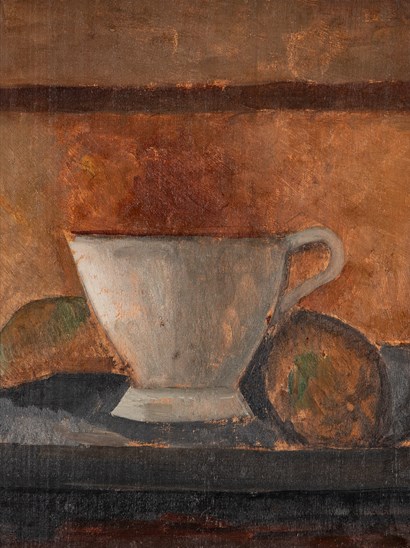
Stern Pissarro Gallery
Pablo Picasso (Malaga 1881-1973 Mougins) Tasse et bananes, 1908 Oil on panel 27 x 21.3 cm Signed on the reverse, Picasso Provenance: Galerie Kahnweiler, Paris; Roger Dutilleul, Paris; Galerie Louise Leiris, Paris; Eugene and Dorothy Prakapas, New York; acquired from the above in November 2000; private collection, New York, thence by descent Literature: Françoise Cachin, Tout l'oeuvre peint de Picasso, 1907-1916, Milan, 1972, n° 169, pp. 95-96 (ill. p. 95); Pierre Daix and Joan Rosselet, Picasso: The Cubist Years 1907-1916, A Catalogue Raisonné of the Paintings and Related Works, London, 1979, n° 208, p. 229 (ill.; titled Cup and Fruit) Christian Zervos, Pablo Picasso. OEuvres de 1906 à 1912, vol. 2, Paris, 1986, n° 100, p. 175 (ill. p. 48); Josep Palau i Fabre, Picasso Cubism (1907-1917), New York, 1990, n° 295, p. 499 (ill. p. 107; titled Cup and Tuber; dated 1909)

Galerie BG Arts
René Lalique Vase 'Deux Anneaux Pigeons', 1919 Made in opalescent glass with grey patina H 33 cm Engraved signature Provenance: private collection, France Literature: Félix Marcilhac, René Lalique - Catalogue Raisonné de l'Œuvre de Verre, Les Éditions de l'Amateur, Paris, 2011, n° 880

